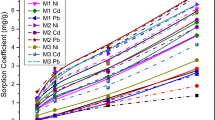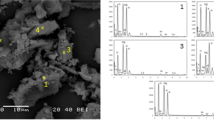Abstract
Background
Cadmium (Cd) is used extencively in many industries and can cause environmenal pollution and severe damage to human health. As millions of tons of lime-based solid by-product from nitrogen fertilizer industry (NFIB) are produced each year, the main purpose of this study was to develop a novel, efficient and cheap nanoscale sorbent from NFIB for remediation of Cd (II) contaminated soil and water to protect and preserve public and ecosystem health.
Methods
A novel nanoscale adsorbent was developed from the nitrogen fertilizer industry byproduct (NFIB) and was characterized using X-ray diffraction(XRD) and scanning electron microscope (SEM). Batch sorption equilibrium and kinetic experiments were conducted to evaluate the efficiency of nano- NFIB (nNFIB) in sequestering Cd(II) in contaminated soil and water.
Results
The results of adorption equilibrium and kinetics experiments revealed that Langmuir and power function models best described Cd adsorption on bulk NFIB and nNFIB as evidenced by high R2(determination coefficient) and low SE(standard error of estimates) values. The Langmuir maximum adsorption capacity (q푞max) of nNFIB for Cd(II) was 100 mg g−1 which is twenty times higher than that of Bulk NFIB. The distinguishing features of NIFB nanoparticles involve efficient removal of Cd(II) from contaminated water (>90%) and enhancement of Cd (II) immobilization (146%) in cotaminated soil.Fourier Transmission Infrared (FTIR) spectra of Cd(II) contaminated water and soil before and after nNFIB application revealed the important rule of calcite nanoparticles in Cd(II) sequestration.
Conclusions
The accessibility, low cost, and Cd sequestration efficiency of nNFIB nominate it to be an economic and a promised adsorbent for environmental remediation.






Similar content being viewed by others
References
Wang Y, Tang X, Chen Y, Zhan L, Li Z, Tang Q. Adsorption behavior and mechanism of Cd(II) on loess soil from China. J Hazard Mater. 2009;172:30–7.
Satarug S, Baker JR, Urbenjapol S, Haswell-Elkins M, Reilly PE, Williams DJ. A global perspective on cadmium pollution and toxicity in non-occupationally exposed population. Toxic Lett. 2003;137:65–83.
Gadepalle VP, Ouki SK, Herwijnen RV, Hutchings T. Immobilization of heavy metals in soil using natural and waste materials for vegetation establishment on contaminated sites. Soil Sediment Contam. 2007;16:233–51.
Mahtab A, Usman AA, Lee SS, Kim SJ, Joo JE, Yang A, Ok YS. Eggshell and coral wastes as low cost sorbents for the removal of Pb2+,Cd2+ and Cu2+ from aqueous solutions. J Ind Eng Chem. 2012;18:198–204.
Elkhatib EA, Mahdy AM, El Manea MN(2013) Drinking water treatment residuals effects on nickel retention in soils: a macroscopic and thermodynamic study. J Soils Sediments13:94–105.
Elkhatib EA, Mahdy AM, Salama KA. Green synthesis of water treatment residual nanoparticles using precision milling. Environ Chem Lett. 2015a;13:333–9.
Mahdy AM, Elkhatib EA, Fathi NO, Lin ZQ. Use of drinking water treatment residuals (WTRs) in reducing bioavailability of metals in biosolid-amended alkaline soils. Commun Soil Sci Plant Anal. 2012;43:1216–36.
Bayat B. Comparative study of adsorption properties of Turkish fly ashes. I. The case of nickel(II), copper(II) and zinc(II). J Hazard Mater. 2002;95:251–73.
Porter AL, Youtie J, Shapira P, Schoeneck DJ. Refining search terms for nanotechnology. J Nanopart Res. 2008;18:715–28.
Elkhatib EA, Mahdy AM, Sherif FK, Salama KA. Water treatment residual nanoparticles: a novel sorbent for enhanced phosphorus removal from aqueous medium. Curr Nanosci. 2015b;11:655–68.
Elkhatib EA, Moharem M, Mahdy AM, Mesalem M. Sorption, release and forms of mercury in contaminated soils stabilized with water treatment residual. Land Degrad Dev. 2017;28:752–61.
USDA. Urban technical note no. 3. Heavy metal soil contamination. Auburn: Soil Quality Institute; 2000.
Tessier A, Campbell PG, Benon M. Trace metal speciation in the Yamaska and St. Francois Rivers (Quebec). Can J Earth Sci. 1980;17:90–105.
SAS Institute. SAS/STAT user’s guide. Version 9.1 edition. Cary: SAS Inst. Inc.; 2002.
Zuo WQ, Chen C, Cui HJ, Fu ML. Enhanced removal of Cd(II) from aqueous solution using CaCO3 nanoparticle modified sewage sludge biochar. RSC Adv. 2017;7:16238–43.
Kurniawan TA, Lo WH. Removal of refractory compoundsfrom stabilized landfill leachate using an integrated H2O2 oxidation and granular activated carbon (GAC) adsorption treatment. Water Res. 2009;43:4079–91.
Song K, Kim W, Ryu T, Ryu KW, Bang JH, Jang YN. Adsorption of Cd(II) on waste calcite produced by the carbonation of flue gas desulfurization (FGD) gypsum. Mater Trans. 2011;52:224–8.
Ma X, Li L, Yang L, Su C, Wang K, Yuan S, Zhou J. Adsorption of heavy metal ions using hierarchical CaCO3–maltose meso/macroporous hybrid materials: adsorption isotherms and kinetic studies. J Hazard Mater. 2012;209–210:467–77.
Tan X, Liu Y, Zeng G, Wang X, Hu X, Gu Y, Yang Z. Application of biochar for the removal of pollutants from aqueous solutions. Chemosphere. 2015;125:70–85.
Cui X, Fang S, Yao Y, Li T, Ni Q, Yang X, He Z. Potential mechanisms of cadmium removal from aqueous solution by Canna indica derived biochar. Sci Total Environ. 2016;562:517–25.
Lu H, Zhang W, Yang Y, Huang X, Wang S, Qiu R. Relative distribution of Pb 2+ sorption mechanisms by sludge-derived biochar. Water Res. 2012;46:854–62.
Appel C, Ma LQ, Rhue RD, Reve W. Sequential sorption of lead and cadmium in three tropical soils. Environ Pollut. 2008;155:132–40.
Rajaie M, Karimian N, Maftoun M, Assaad M. Chemical forms of cadmium in two calcareous soil textural classes as affected by application of cadmium-enriched compost and incubation time. Geoderma. 2006;136:533–41.
Chen ZS, Lee GJ, Liu JC. The effects of chemical remediation treatments on the extractability and speciation of cadmium and lead in contaminated soils. Chemosphere. 2000;41:235–44.
Ma X, Cui W, Yang L, Yang Y, Chen H, Wang K. Efficient biosorption of lead(II) and cadmium(II) ions from aqueous solutions by functionalized cell with intracellular CaCO3 mineral scaffolds. Bioresour Technol. 2015;185:70–8.
Reig FB, Adelantado VG, Moreno MM. FTIR quantitative analysis of calcium carbonate (calcite) and silica (quarts) mixtures using the constant ratio method. Talenta. 2002;58:811–21.
Cai GB, Zhao GX, Wang XK, Yu SH. Synthesis of polyacrylic acid stabilized amorphous calcium carbonate nanoparticles and their application for removal of toxic heavy metal ions in water. J Phys Chem. 2010;114:12948–54.
Zhao X, Jiang T, Du B. Effect of organic matter and calcium carbonate on behaviors of cadmium adsorption-desorption on/from purple paddy soils. Chemosphere. 2014;99:41–8.
Acknowledgments
This work was financially supported by Alexandria University, Vice Deanship of research. The support of the University is greatly appreciated.
Author information
Authors and Affiliations
Corresponding author
Ethics declarations
Declaration
Not applicable.
Ethics approval and consent to participate
Not applicable.
Consent for publication
Not applicable.
Competing interests
The authors declare that they have no competing interests.
Additional information
Publisher’s note
Springer Nature remains neutral with regard to jurisdictional claims in published maps and institutional affiliations.
Rights and permissions
About this article
Cite this article
Elkhatib, E., Mahdy, A., Mahmoud, A. et al. Efficient removal of Cd (II) from contaminated water and soils using nanoparticles from nitrogen fertilizer industry waste. J Environ Health Sci Engineer 17, 1153–1161 (2019). https://doi.org/10.1007/s40201-019-00429-z
Received:
Accepted:
Published:
Issue Date:
DOI: https://doi.org/10.1007/s40201-019-00429-z




